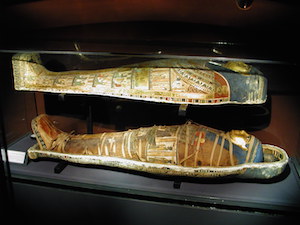In the earliest periods, bodies were not mummified. They were placed in pits in the dry desert sand, sometimes wrapped in linen or covered with reeds. The hot sands dried out the bodies naturally, and this may have been the spark which inspired the Egyptians to experiment with the preservation of their dead. By the Naqada II phase of Predynastic history, resins were used to help preserve the body and to make the corpse smell better.
There was more than one way to mummify a body, only the wealthy could afford the full works. There were also changes in the process of mummification over time. On this page we will look at the classic method as it was performed during the New Kingdom on famous pharaohs such as Tutankhamun. We will also get a little help from the Roman writer Herodotus who gave a thorough description of the ritual during the Roman Period.

The whole ritual took seventy days, although the full embalming procedure itself only took forty days. The Egyptians noted that the decans (a group of stars which were important in Egyptian astronomy) dipped below the horizon for seventy days before reappearing, and they hoped that, like the stars, the body could be reborn after seventy days. In practice, the ritual could be conducted much faster or slower. A text confirms that one burial in the worker’s village of Deir el Medina took place only two days after death, while another records that the body of an Old Kingdom noble named Senedjemib-Inti waited almost 500 days to be buried!
How to make a Mummy
First, the body was taken to a temporary structure made of reed and mat which was called the “ibu” (tent of purification) where it was cleaned using palm wine and sweet smelling herbs and spices. It was then moved to the “wabet” (pure place) a red or stone building which was a bit like a modern morgue.

The embalmer used a hooked tool to break the ethmoid bone in the nose, and scoop out the brain (excerebration), which they threw away. A small cut was made in the body to allow the embalmer to remove the internal organs (evisceration), but not the heart (which they though was the source of a person’s personality and intelligence). The other organs were dried (desiccated), preserved in resins and oils, and wrapped in linen before being placed in the canopic jars (or on the body).
Next, the body had to be dried out by being covered in natron (a natural salt). Natron and sweet smelling resins were also packed into the body cavity, and the body was left for seventy days (or so). Once the body was dry, the natron was carefully washed off and the body was packed with linen, sawdust and other materials such as incense resins and spices to return it to a more natural shape. False eyes were placed under the eyelids. In some cases the dummy eyes were formed from quartz or stone but in more than one case they used small onions! Sometimes the skin was painted (red for a man, yellow for a woman) and makeup applied.
The body was then ready to be wrapped in linen. Linen was expensive, so in poorer burials clothing was recycled as bandages. Even some pharaohs had to make do with recycled linen sheets. Tutankhamun, however, had linen specially woven for his burial. As the priests carefully wrapped the body in linen it was anointed with ritual oils and resins, spells were spoken, and magical amulets placed within the wrappings to protect the body and help the person in their journey through the underworld. Sometimes the linen wrappings also had spells written on them.
Once the wrapping was complete, a linen shroud was placed over the body. This was often plain, but could also be decorated with images of the god Osiris, the king of the underworld who awaited the dead in the Hall of Judgement. Some Egyptologists have suggested that in creating the mummy, the Egyptians hoped to make the dead body into an image of Osiris to guarantee the person would enjoy eternal life.
The body was now ready for the funeral, and the most important funerary ritual during which the mummy would be reanimated – the Opening of the Mouth.
The Evolution of Mummification
Opening of the Mouth
Bibliography
- Grajetzki, W (2003) Burial Customs in Ancient Egypt
- Ikram, Salima (1997) Death and Burial in Ancient Egypt
- Ikram, Salima and Dodson, Aidan (1998) The Mummy in Ancient Egypt
- Teeter, Emily (2011) Religion and Ritual in Ancient Egypt
Copyright J Hill 2017